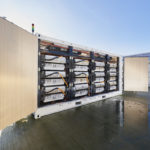Matthew Lumsden, CEO at Connected Energy, explains how a second ‘behind the scenes tour’ of AMRC North West demonstrates how battery storage can help local authorities build energy resilience while maximising budgets and meeting eco targets.
Local authorities are under renewed pressure to maximise their sustainability budgets to meet increasingly tight targets, and only significant changes to their electricity generation and supply chain can achieve the carbon zero compliance required.
A second sell out ‘behind the scenes’ tour of the Advanced Manufacturing Research Centre (AMRC) North West and its energy management systems, organised by Connected Energy, recently allowed visitors to see the renewable technologies in action and learn how batteries can manage and reduce energy bills and lower carbon emissions, all whilst increasing energy consumption and security.
Solutions demonstrated at AMRC can be applied to existing buildings or new sites for local authorities looking to solar and wind generated power as the key to energy resilience, alongside potential additional income.

Demo site proves battery value
The demo site at AMRC presents a road map for site and building managers that will enable them to cut the carbon footprint of older facilities and achieve net zero by 2050. Visitors have been keen to see the renewable technologies in action and learn how batteries can manage and reduce energy bills and reduce carbon emissions, all whilst increasing energy consumption and security in buildings.
“It’s not about telling others to buy the latest equipment to reduce their emissions, but rather demonstrating how they can make their existing infrastructure greener and more efficient by retrofitting digital technologies,” said Ben Smith, Low Carbon Building Specialist at AMRC North West.
The battery unit at the AMRC is linked to a range of renewable technologies and sensors which together allow the site to store and use its own clean energy, always keeping the centre on its green tariff and serving as the data ‘heart’ of a new fully digitised building and manufacturing facility.
Making ‘Industry 4.0’ a reality — where efficiencies and improvements are identified and made through real time data analysis, AI application and learning via remote control — thousands of sensors on each piece of equipment will gather information about energy use, and feed this through a single dashboard.
By aligning meteorological data with data from the IIoT and battery cells, and using AI and data modelling, the BESS will be automatically made available to charge from solar or the grid according to which will be most profitable, appropriate for the weather, or energy needs at any given time.
The AMRC also shows how buildings can automatically switch between the BESS and the national grid to minimise costs and maximise revenue through arbitrage.

Keeping sites powered
Battery energy storage allows sites to store energy — either directly from the grid or from their own renewables — and use it when it is required. Connected Energy’s current 300kW system, for example, could provide 100kW per hour to a site. This energy supply could power one piece of critical equipment, or it could be spread over a building to maintain heating and lighting. With larger multi-MW systems, like the type under development by Connected Energy, storage systems could keep a whole building operating for an extended period. For many local authorities it will be difficult to maximise their renewable energy in any other way but with storage.
A battery storage unit can also save a substantial amount of money and operational headaches at sites such as fleet depots, which can become grid constrained due to additional pressures from EV charging where local authorities are working to decarbonise their fleet. For example, if a depot requires EV charging which might exceed the available capacity on the grid, it can be taken from battery storage; if there is a significant load during a peak tariff period, it can be managed using low cost or locally generated supply; or if there is a good value night rate it’s possible to charge a battery with the cheaper rate and offset higher costs later in the day.
Engaging with smart technology
Energy supply and resilience solutions lie in the planning and installation of smart, local energy systems. Local government should focus on integrating renewable generation with battery storage, alongside connected digital technology in existing and new buildings.
With the increased uptake and development of electric vehicle charging and vehicle to grid exchange, a local energy system would allow a local authority property or site to create a private network. With the ability to isolate from the main grid when required, these networks can remove reliance on the national supply, allowing them to operate independently when needed, providing a flexible and clean energy system.
Contrary to popular belief, battery systems do not need to be linked to solar panels or wind turbines to deliver cost and carbon savings — standalone battery units can be utilised in several ways to benefit existing buildings.
A battery can be used to selectively store energy from the national grid so that a site always remains within its green tariff. It can also be used to make additional revenue by supporting imbalances in the grid when it’s needed back, which the National Grid will pay for as a service.
Battery storage can also be used to support a site against energy fluctuations, protecting buildings from damaging electricity brownouts or blackouts. These functions can be managed by a smart technology management platform, which uses data analysis to select the most valuable outcomes for the asset owners relating to reducing carbon footprints and energy use on site.
 Utilising second life cells
Utilising second life cells
What will be particularly appealing to councils with challenging Climate Strategy and Action Plan targets, is that battery systems from Connected Energy are made from second life car batteries. Each unit contains 24 used Renault Kangoo batteries.
While operationally identical to units made from brand new batteries, these second life storage units provide a positive carbon benefit of 450tCO2e for every 1MWh installed compared with a first life energy storage unit. This kind of carbon saving is hard to achieve in any other way. Furthermore, the raw materials used in lithium-ion batteries are costly and difficult to extract, alongside costly to manufacture and recycle. Second life battery cells bypass supply chain issues, and they are a cheaper and more environmentally friendly alternative, whilst functioning at the capacity required with no compromise to performance.
De-centralised energy is the future
Energy network resilience and achieving climate driven sustainability targets are two critical focus points for local authorities. The development of de-centralised and locally generated energy backed with battery storage is clearly the rational choice for many council owned properties.
With bigger and more powerful battery systems, councils can build a smarter network capturing the full value of renewable energy and offer power to all essential services even when the sun is not shining, or the wind is not blowing.
The energy revolution is just around the corner — and battery energy storage will be a key component in secure and resilient energy systems for local authority buildings across the UK.










